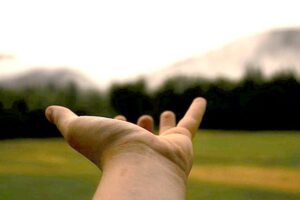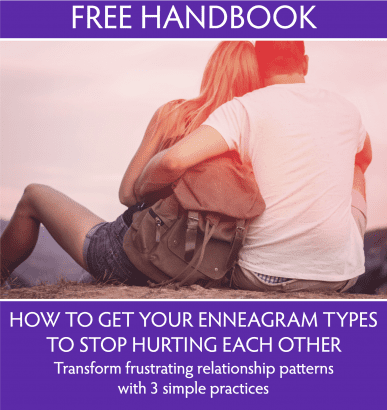Perhaps you have heard the saying,
“When you have a hammer in your hand, everything looks like a nail.”
Do you notice that people in your life tend to take a similar approach toward really different situations? Like your friend who treats every interaction as a potential self-promotion opportunity? We all do something like this, whether we’re conscious of it or not. We are, in large part, creatures of habit, basing our understanding of the world on what we’ve perceived before. As much as we like to think of ourselves as free agents, much of our attention is spent gathering evidence to support our well-grooved world view.
I don’t know about you, but that is a little disappointing to me- like I’m a bit of a robot or a dog conditioned to do the same trick over and over hoping for a reward. I understand that relying on patterns is an efficient way for our minds and bodies to work- not to have to reorient to each situation freshly every moment. It would be problematic if we had to relearn words in our mother tongue each day, or if we had to figure out directions for our daily commute.
But, I love it when I get the sense that my default way of experiencing the world doesn’t have to determine how I operate from moment to moment. It’s good in a certain way to have a groove to function, and it’s good in another way to not be determined by it if we want to flourish. It’s when we use our favorite perspective unconsciously that we typically run into trouble.
When I looked up the hammer and nail quote, I found it can be tracked back first to Abraham Kaplan in his 1964 Conduct of Inquiry: Methodology for Behavioral Science. He wrote, ”I call it the law of the instrument, and it may be formulated as follows: Give a small boy a hammer, and he will find that everything he encounters needs pounding.”
A similar description can be found in Abraham Maslow’s Psychology of Science (1966) where he said, “I suppose it is tempting, if the only tool you have is a hammer, to treat everything as if it were a nail.”
Let’s say we each have a tool belt around our psychological hips that is well-stocked with all the basic tools needed for the project of life in front of us. Which are your favorite tools? Which is your favorite “go-to” for lots of jobs? Although we have the innate capacity to use most of our collection of tools, we tend to ignore or not consider using many of them.
We could see the specialties of each of the nine Enneagram types as a particular kind of tool. If my core point of view (preferred tool) points me toward how to look for downsides in order to prevent bad things from happening (6), and I use that same tool on most things that come into my awareness, I am likely to focus on select themes in any given situation. I will tend to assume bad things are likely to happen at any time. My mind will be primed for vigilance and problem-solving. Through this lens, I may perceive things as sinister that aren’t actually a threat at all. Compared with other types, I am likely to miss experiencing when things are going smoothly and thus miss out on a feeling of supported ease in my daily life when there isn’t a crisis.
Each Enneagram style has a primary focus of attention. Sometimes our particular focus is not the most appropriate tool for the job in front of us. For example, the Seven’s gift of positive possibilities and joy would feel unwelcome for someone who has recently lost a loved one. Or a Two’s wish to be helpful and needed could really clash in an occupation where the goal is to develop others’ independence.
A friend of mine often wants to feel the edgy parts of me. As a Nine, when I’m on autopilot, I tend to present things in a smooth, unruffled way, with the underlying belief that I shouldn’t disturb anyone or cause any trouble. My friend, a Four, loves to be stirred up and feels unmet when I hold back my edgy feelings. So in this case, my trying to avoid conflict to stay connected, I inadvertently elicit conflict between us where we both end up feeling disconnected. In that moment, she did not want my usual tool (sandpaper?) to make things more smooth. Especially when we’re afraid or reactive, we tend to use our favorite tool more strongly or frequently, and feel very little awareness about other choices in our tool belts.
In our fullness, we each have all of the Enneagram types within us. The diagram can be seen as a map our full potential. It is right that we each have one core approach, both for efficiency and to deliver our gifts to the collective. It is good that we are limited in a particular way so that we can become specialists. And it is, indeed, limiting. It limits how we think of ourselves and the world. It limits how we operate in life and with others. It even limits what we perceive.
So, what if we could keep our specialty, and also develop more flexibility and choice so that we can meet whatever is arising in the moment with the tool or perspective most needed for the “job?”
The good news is, there’s never yet been an account of someone losing their personality’s super-power by adding in more options. The bad news is, it’s rarely easy to put down our favorite tool. It is rare to even be aware of which tool we’re using. Sometimes life will twist the beloved hammer out of our hands, but our deep survival patterns and beliefs put up a good fight and hold on tight- maybe wanting to hammer on life in protest. It can feel as if letting go of the world-view or identity we insist upon will rock the existential boat too radically to imagine.
For an Eight, who tends to prefer to feel strong, allowing oneself to be tender can be very difficult, even in situations where there is trusted support. It is often not simple or easy for someone with the Eight strategy to just choose to add in more degrees of vulnerability because it sounds more balanced. It can actually feel like life-or-death. It sounds foolish.
Similarly, let’s say someone with a Five point of view decides, “I’m going to allow in my emotions more strongly so that I can have a more complete picture of life.” This not only goes against everything the Five has banked on for protection and orientation, but doing so without care and guidance could blow their circuits. More likely, it could just remain a good idea, but one that feels confounding about how to take action on.
So, while I can say, “Let’s use all the tools in the box, people!” I don’t say it casually. I say it as an invitation to investigate how we actually use our attention and energy in the world, and to see where our favorite tool is working well for us and for others, and where it isn’t.
It can be said that a lot of our trouble comes from an overuse of our strengths. We just continue to do too much of the thing that seemed to be the ticket early in life. And we’re often better at our gig than others are. Fours are often much more capable than other types at feeling into the depths of emotion and layers of meaning than others are- or than others care to be. The other types are neither as motivated, nor as fulfilled by focusing there on a regular basis.
Our strengths can even give us the opposite of what they’re aiming for. As a One, for example, I want to feel that things are as they should be. And yet, my lens is having me incessantly focus on error. My desire has trained my attention to look for what’s wrong in order to correct it. This makes the likelihood that I’ll experience the rightness of things very slim. This phenomenon itself could make me more frustrated because it feels wrong that I have this type or that it’s messing things up my ability to feel things are right.
There are many strengths within each enneatype, but I’ll offer one example for each that can illustrate how a strength can be overused and become a liability, both interactionally and inwardly.
For enneatype One, a strength is discerning “the right thing.” When I overuse this strength, I can become righteous, irritated, or disappointed with others and the world. I can become blind to the “rightness” of all that is.
For enneatype Two, a strength is feeling into what others need. When I overuse this strength, I can become intrusive, presumptuous, or disconnected from my own needs. I can become blind to the natural give and take inherent in life.
For enneatype Three, a strength is presenting a successful image. When I overuse this strength, I can become superficial, calculating, or confused about who I truly am. I can become blind to my authentic experience regardless of audience.
For enneatype Four, a strength is unique and creative expression. When I overuse this strength, I can become melodramatic, feel excluded, or dissatisfied with my life. I can become blind to how simply living and being is a creative expression of the universe through me.
For enneatype Five, a strength is seeing things objectively. When I overuse this strength, I can become emotionally distant, disengaged, or cut off from the vitality of life. I can become blind to my visceral and heartful belonging to this life.
For enneatype Six, a strength is loyalty to others or causes. When I overuse this strength, I can become servile, combative, or stay too long with things that aren’t life-giving. I can become blind to the spiritual ground and support that is available to me without dutiful adherence.
For enneatype Seven, a strength is seeing the positive side of things. When I overuse this strength, I can become dismissive, rationalizing, or disconnected from the truth of the moment. I can become blind to the value in all of life’s experiences, including those perceived as painful.
For enneatype Eight, a strength is protecting the innocent. When I overuse this strength, I can become aggressive, alienating, or lose sight of my own vulnerability. I can become blind to the fresh truth of each moment that includes all aspects of myself and of others.
For enneatype Nine, a strength is understanding multiple viewpoints. When I overuse this strength, I can become adrift, impassive, or disconnected from my own truth. I can become blind to my own value and of the particular truth only I can deliver.
Developing awareness of the automatic patterns seems to be the key in loosening their determining grip. And while this is simple, I’ll reiterate that it is not usually easy, especially in the beginning. With practice, I can more often “catch myself in the act” of my type strategy— when I observe that I’m pulling out my screwdriver to decorate a cake for example— I can potentially open up to what else might be possible in the situation.
As a Three, I might find myself in a conversation with someone I don’t respect but feel compelled to impress. Paying attention to how “forward” or “off my axis” I feel in the moment, I might notice that something feels incongruent inside. This could trigger the possibility of a simple acknowledgement of my usual tool: “Oh! There you are again coming in to try to help me feel approved of.” I might then be able to take a breath, reground myself, and open up to what else might want to arise in my fresh, organic intelligence in the present moment.
In the next week, would you like to experiment with noticing a particular strength of your enneatype’s approach and where it shows up? In reflection you could ask:
- Where does my approach fit really well? If my favorite tool is a drill, then I might feel its usefulness when life is asking for a passageway through something.
- Where does my strength create difficulties for me or for others? If my usual tool is a saw, it might not be optimal when corners are needing to be joined together.
- How might I open to inspiration about what kind of energy is being asked for in the situation in the moment?
Please share your own experiences below about how your strength causes you trouble, or how you open yourself to new possibilities.







2 Responses
Thanks for this wonderful post and the great metaphor of tools… I can imagine myself with a leather carpenter’s belt, carrying more than one tool to help me remember that I get to choose which tools to use. As a 5 type, my non intrusive habit often prevents me from asking the good questions to deepen a new friendship… to let another person know that I am interested in knowing more about them. If I overuse this strength ( which is very helpful in some situations), then I don’t make the connections that I truly want to make. Now let’s see… which tool would that be…? Perhaps I can use a number of tools to build a doorway.
Thanks for your reflection. I like thinking about the different tools that might be needed for creating a doorway (my own readiness to do something different), and for making connections (my willingness to share and inquire).